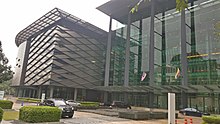South East Asian Central Banks Research and Training Centre

Since its inception in the early 1980’s, The SEACEN Centre has established its unique regional position in serving its membership of central banks in the Asia-Pacific region through its learning programmes, research work, and networking and collaboration platforms for capability building in central banking knowledge.
Over the years, SEACEN has built a wide network base, in that besides its members, the Centre has an outreach of 15 other central banks and monetary authorities which are invited for the Centre’s learning programmes, as well as 26 regional and international strategic partners with whom the Centre collaborates in the design and delivery of its programmes in central banking knowledge areas (Macroeconomic and Monetary Policy Management; Financial Stability and Supervision; and Payment and Settlement Systems and Leadership and Governance).
History
[edit]The history of The SEACEN Centre is closely tied with the annual meetings of the governors of the South East Asian central banks. The idea of setting up a centre for monetary studies and training in the region was mooted during the Second Governors Conference held in the Philippines in 1967. At their seventh meeting in Kuala Lumpur in 1972, the governors agreed for a single centre for both research and training be established in Kuala Lumpur. Work to establish The SEACEN Centre commenced in 1973. In 1982, The South East Asian Central Banks (SEACEN) Research and Training Centre was established as a legal entity. Since then, its membership has grown from eight central banks/monetary authorities to nineteen currently.
The SEACEN Centre has established its unique regional position in serving its membership of central banks in the Asia-Pacific region through its learning programmes, research work, and networking and collaborative platforms for central banking capacity building. The SEACEN Centre’s programme offerings are currently focused in three central banking knowledge areas: Macroeconomic and Monetary Policy Management; Financial Stability Supervision and Payment and Settlement System; and Leadership and Governance.
Members
[edit]- Brunei Darussalam Central Bank
- National Bank of Cambodia
- People's Bank of China
- Hong Kong Monetary Authority
- Reserve Bank of India
- Bank Indonesia
- Bank of Korea
- Bank of the Lao PDR
- Bank Negara Malaysia
- Bank of Mongolia
- Central Bank of Myanmar
- Nepal Rastra Bank
- Bangko Sentral ng Pilipinas
- Monetary Authority of Singapore
- Central Bank of Sri Lanka
- Bank of Papua New Guinea
- Central Bank Chinese Taipei
- Bank of Thailand
- State Bank of Vietnam
